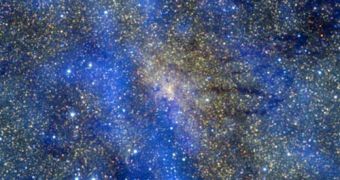The material surrounding and circling the black hole of the Milky Way, called Sagittarius A*, emits flares of radiation. Two Chilean telescopes have managed to spot the event simultaneously for the first time. This allows for a better understanding of the phenomena going on in that place, otherwise unobservable due to the nature of the black holes, which don't allow for light or material to escape from within their grasp.
Although the black holes themselves are nearly impossible to detect from astronomical distances, the material swirling in the immediate vicinity of their event horizon is extremely heated, up to a point where it emits observable radiation. It is believed that all, or at least most of the galaxies in the known universe, contain such mysterious formations at their core. Although the black hole of the Milky Way (called Sagittarius A*) is far from being highly active, it can still generate such bursts, as indicated by the recent observations.
Featuring a mass of around 4 million greater than the Sun's, our galactic black hole is located approximately 26,000 light-years far from the Earth. The telescopes involved in the European-US study were the Very Large Telescope (VLT) belonging to the European Space Organization (ESO), which observed the flares at near-infrared wavelengths, and the Atacama Pathfinder Experiment (APEX) telescope, which tracked the radiation's submillimeter wavelengths.
"Observations like this, over a range of wavelengths, are really the only way to understand what's going on close to the black hole," explained the leader of the team, Andreas Eckart, from the University of Cologne, quoted by Live Science. Referring to Sagittarius A*, the team member from the Massachusetts Institute of Technology (MIT), Frederick K. Baganoff, stated that "Only for this one object can our current telescopes detect these relatively faint flares from material orbiting just outside the event horizon".
During six hours, four extremely varied flares were spotted in infrared, and the emissions recorded by the submillimeter-wavelength observation only started an hour after the infrared ones. Scientists believe that this is due to the very fast expansion of the burst-emitting gas clouds (around 5 million km/h or 3.1 million mph). They think that the gaseous bubble is moving too slowly, at only 0.5% of the speed of light, which is 100 times slower than the required velocity that would allow it to escape the influence of the black hole. This causes it to stretch as it is being pulled in, which generates the radiation bursts.

 14 DAY TRIAL //
14 DAY TRIAL //